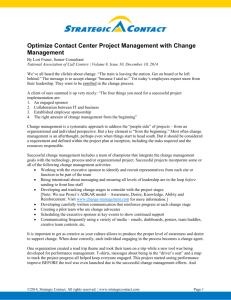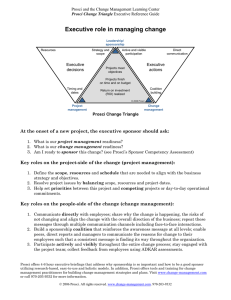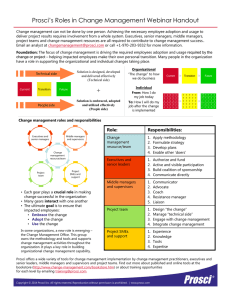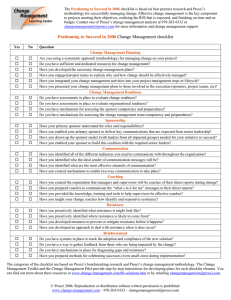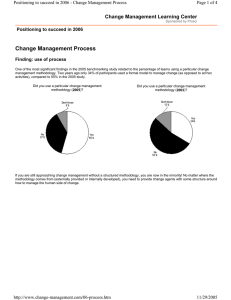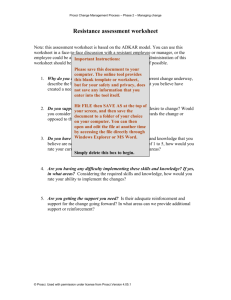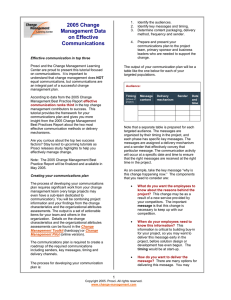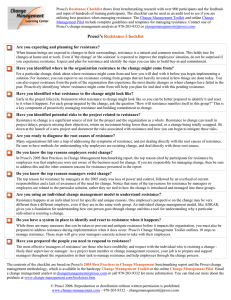The 10-minute primer on change management An executive overview by Prosci
advertisement
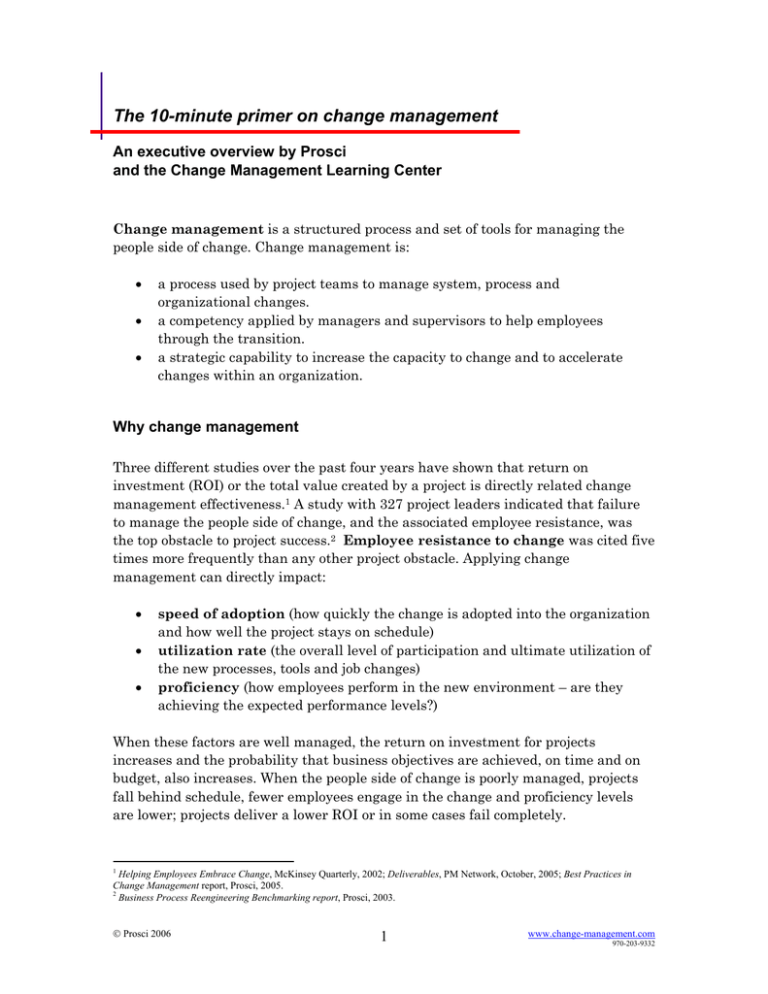
The 10-minute primer on change management An executive overview by Prosci and the Change Management Learning Center Change management is a structured process and set of tools for managing the people side of change. Change management is: • • • a process used by project teams to manage system, process and organizational changes. a competency applied by managers and supervisors to help employees through the transition. a strategic capability to increase the capacity to change and to accelerate changes within an organization. Why change management Three different studies over the past four years have shown that return on investment (ROI) or the total value created by a project is directly related change management effectiveness.1 A study with 327 project leaders indicated that failure to manage the people side of change, and the associated employee resistance, was the top obstacle to project success.2 Employee resistance to change was cited five times more frequently than any other project obstacle. Applying change management can directly impact: • • • speed of adoption (how quickly the change is adopted into the organization and how well the project stays on schedule) utilization rate (the overall level of participation and ultimate utilization of the new processes, tools and job changes) proficiency (how employees perform in the new environment – are they achieving the expected performance levels?) When these factors are well managed, the return on investment for projects increases and the probability that business objectives are achieved, on time and on budget, also increases. When the people side of change is poorly managed, projects fall behind schedule, fewer employees engage in the change and proficiency levels are lower; projects deliver a lower ROI or in some cases fail completely. 1 Helping Employees Embrace Change, McKinsey Quarterly, 2002; Deliverables, PM Network, October, 2005; Best Practices in Change Management report, Prosci, 2005. 2 Business Process Reengineering Benchmarking report, Prosci, 2003. Prosci 2006 1 www.change-management.com 970-203-9332 Roles in change management The key roles in change management include: Primary sponsor – The primary sponsor is the individual who authorizes and funds the project. This person is usually in control of the resources, systems and people that are affected by the change. Sponsor – Sponsor refers to any senior or mid-level manager with responsibility for employees or systems impacted by the change. In this context, a sponsor is defined to be any business leader whose support and active engagement is necessary for the change to be successful. In some cases the term “stakeholder” is also used to refer to this role. Sponsorship – Sponsorship refers to a manager’s support for a change and the associated behaviors of a good sponsor. These behaviors include active and visible engagement throughout the project, effective communications to employees and coalition building with peers and subordinates. Sponsor coalition – The sponsor coalition is defined to be the collection of sponsors within the organization who have direct control over the employees, processes and systems impacted by the change. A strong sponsor coalition is a good indicator of project success, whereas a weak sponsor coalition is a good indicator that projects will fall behind schedule, miss objectives or fail completely. Coach – A coach is any manager who has employees with a direct reporting relationship. A coach is that person who helps their employees through the transition process. Project leader – This role is assigned to that individual who has overall responsibility to implement the project. This individual would have direct day-to-day control over the project team, project management activities and all resources associated with the project. Change management leader – This role is assigned to an individual who creates and implements change management plans for a project. Change management plans include communications, sponsorship, coaching, training and resistance management. Prosci 2006 2 www.change-management.com 970-203-9332 Understanding the change management process Change management has two components: organizational change management and individual change management. Organizational change management is a process for designing and implementing change management activities that affect broad groups of employees. These activities include: Phase 1 • Readiness assessments, risk assessments and strategy development • Identifying and preparing change management resources on the project team • Creating the necessary sponsorship model and preparing sponsors to effectively lead the change Phase 2 • Preparing a communications plan for the project • Creating a roadmap for all key sponsors of the change • Developing a plan to help supervisors coach employees through the transition • Creating a training plan • Developing a resistance management strategy • Integrating change management with project management Phase 3 • Auditing compliance with the change and measuring performance • Identifying root causes to resistance and addressing those points of resistance • Celebrating successes and transitioning the project over to day-to-day operations Individual change management is a process for managing change at an individual level with each employee. This process includes coaching an employee through the change process and developing professional development plans. The process for managing change on an individual level has five elements that serve as the sequential building blocks of success. This change model is referred to as ADKAR.3 1. 2. 3. 4. 5. 3 Awareness of the need for change. Desire to engage and participate in the change. Knowledge on how to change. Ability to implement the change. Reinforcement to sustain the change. ADKAR: A model for change in business, government and our community, Prosci Research, 2006. Prosci 2006 3 www.change-management.com 970-203-9332 Change management structure and deployment An effective framework for deploying change management has five elements: • • • • • Sponsorship Project Process Competency Structure Each element plays a unique role in the successful execution of change management. Sponsorship – the leadership team for the organization plays a central role in sponsoring a change. First, a primary sponsor must be assigned who matches the criteria for primary sponsor for each major change initiative. Second, all business leaders who are impacted by a change must play a role in sponsoring that change throughout the organization. Effective sponsorship behaviors include: • • • Direct communication with employees about why the change is happening and how the change aligns with the vision for the organization. Coalition building with other business leaders who have employees impacted by the change to ensure a strong sponsorship coalition. Visible and active participation throughout the entire project. Project – The project team must develop and implement change management plans for their project that supports the unique type of change and that aligns with the organization impacted by the change. This will require change management training and resources on the team with the skills, knowledge and tools to implement change management plans. Process – The organization must select a change management methodology and tools to deploy with the project and with business leaders. Using a structured and formalized process for managing change reduces the costs and increases the effectiveness of the change management program. Competency – Business leaders and managers in the organization will need some level of proficiency in change management in order to carry out their respective roles. For example, senior and mid-level managers will need competency in effective sponsorship. Supervisors will need training on how to effectively coach employees through the change process. Prosci 2006 4 www.change-management.com 970-203-9332 Structure – Most organizations require some type of support infrastructure to maintain change management processes, tools and compliance across multiple projects. This function normally is a staff role. Summary Change management is about helping employees through the change process in order to: • • • • Accelerate change within an organization and reduce the disruption to dayto-day operations. Increase the value recovered or ROI from change projects. Ensure that projects are on-time and on-budget. Increase an organization’s change capacity and the associated responsiveness to market changes. To find out more about change management for your organization, contact Prosci at 970-203-9332 or visit the Change Management Learning Center at www.changemanagement.com About Prosci Prosci is an independent research company that was formed in 1994. Since that time, Prosci has become the worldwide leader in change management research with data from more than 900 organizations in 59 countries. Prosci's Learning Centers host more than 80,000 registered participants in tutorial series and benchmarking programs. Prosci’s latest change management book ranks number one on Amazon.com and Prosci’s comprehensive change management training programs are offered world-wide. Our product and training customers include a majority of the Fortune 100 companies and have included the Department of Defense, Southern California Edison, CUNA Mutual Group, United Nations, Halliburton Energy Services, the US Department of Interior, the Zambian Electrical Supply Company, Ltd. and Aventis-Pasteur to name only a few. Our training options include distance learning, customized on-site programs and open-enrollment sessions in Colorado, USA. Our trainers are seasoned executives and hold advanced degrees in related areas; all have years of industry experience in Fortune 500 companies. Our offices are located at: Prosci Research, 1367 South Garfield Avenue, Loveland, Colorado, USA, 80537 Phone: 970-203-9332 Fax: 970-669-7005 Prosci 2006 5 www.change-management.com 970-203-9332
